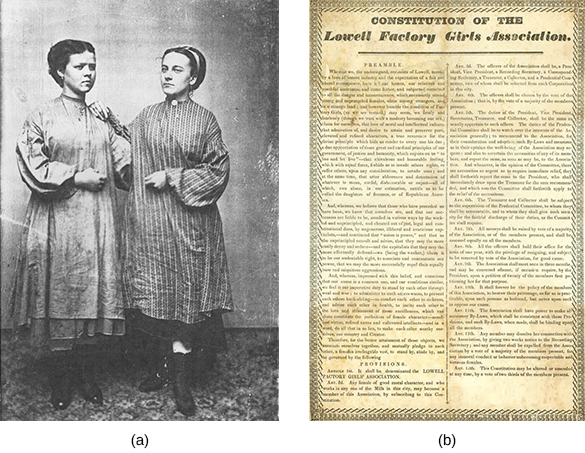| << Chapter < Page | Chapter >> Page > |
Many workers undoubtedly enjoyed some of the new wage opportunities factory work presented. For many of the young New England women who ran the machines in Waltham, Lowell, and elsewhere, the experience of being away from the family was exhilarating and provided a sense of solidarity among them. Though most sent a large portion of their wages home, having even a small amount of money of their own was a liberating experience, and many used their earnings to purchase clothes, ribbons, and other consumer goods for themselves.
The long hours, strict discipline, and low wages, however, soon led workers to organize to protest their working conditions and pay. In 1821, the young women employed by the Boston Manufacturing Company in Waltham went on strike for two days when their wages were cut. In 1824, workers in Pawtucket struck to protest reduced pay rates and longer hours, the latter of which had been achieved by cutting back the amount of time allowed for meals. Similar strikes occurred at Lowell and in other mill towns like Dover, New Hampshire, where the women employed by the Cocheco Manufacturing Company ceased working in December 1828 after their wages were reduced. In the 1830s, female mill operatives in Lowell formed the Lowell Factory Girls Association to organize strike activities in the face of wage cuts ( [link] ) and, later, established the Lowell Female Labor Reform Association to protest the twelve-hour workday. Even though strikes were rarely successful and workers usually were forced to accept reduced wages and increased hours, work stoppages as a form of labor protest represented the beginnings of the labor movement in the United States.

Critics of industrialization blamed it for the increased concentration of wealth in the hands of the few: the factory owners made vast profits while the workers received only a small fraction of the revenue from what they produced. Under the labor theory of value , said critics, the value of a product should accurately reflect the labor needed to produce it. Profits from the sale of goods produced by workers should be distributed so laborers recovered in the form of wages the value their effort had added to the finished product. While factory owners, who contributed the workspace, the machinery, and the raw materials needed to create a product, should receive a share of the profits, their share should not be greater than the value of their contribution. Workers should thus receive a much larger portion of the profits than they currently did, and factory owners should receive less.
In Philadelphia, New York, and Boston—all cities that experienced dizzying industrial growth during the nineteenth century—workers united to form political parties. Thomas Skidmore, from Connecticut, was the outspoken organizer of the Working Men’s Party , which lodged a radical protest against the exploitation of workers that accompanied industrialization. Skidmore took his cue from Thomas Paine and the American Revolution to challenge the growing inequity in the United States. He argued that inequality originated in the unequal distribution of property through inheritance laws. In his 1829 treatise, The Rights of Man to Property , Skidmore called for the abolition of inheritance and the redistribution of property. The Working Men’s Party also advocated the end of imprisonment for debt, a common practice whereby the debtor who could not pay was put in jail and his tools and property, if any, were confiscated. Skidmore’s vision of radical equality extended to all; women and men, no matter their race, should be allowed to vote and receive property, he believed. Skidmore died in 1832 when a cholera epidemic swept New York City, but the state of New York did away with imprisonment for debt in the same year.
Worker activism became less common in the late 1840s and 1850s. As German and Irish immigrants poured into the United States in the decades preceding the Civil War, native-born laborers found themselves competing for jobs with new arrivals who were willing to work longer hours for less pay. In Lowell, Massachusetts, for example, the daughters of New England farmers encountered competition from the daughters of Irish farmers suffering the effects of the potato famine; these immigrant women were willing to work for far less and endure worse conditions than native-born women. Many of these native-born “daughters of freemen,” as they referred to themselves, left the factories and returned to their families. Not all wage workers had this luxury, however. Widows with children to support and girls from destitute families had no choice but to stay and accept the faster pace and lower pay. Male German and Irish immigrants competed with native-born men. Germans, many of whom were skilled workers, took jobs in furniture making. The Irish provided a ready source of unskilled labor needed to lay railroad track and dig canals. American men with families to support grudgingly accepted low wages in order to keep their jobs. As work became increasingly deskilled, no worker was irreplaceable, and no one’s job was safe.
Industrialization led to radical changes in American life. New industrial towns, like Waltham, Lowell, and countless others, dotted the landscape of the Northeast. The mills provided many young women an opportunity to experience a new and liberating life, and these workers relished their new freedom. Workers also gained a greater appreciation of the value of their work and, in some instances, began to question the basic fairness of the new industrial order. The world of work had been fundamentally reorganized.

Notification Switch
Would you like to follow the 'U.s. history' conversation and receive update notifications?